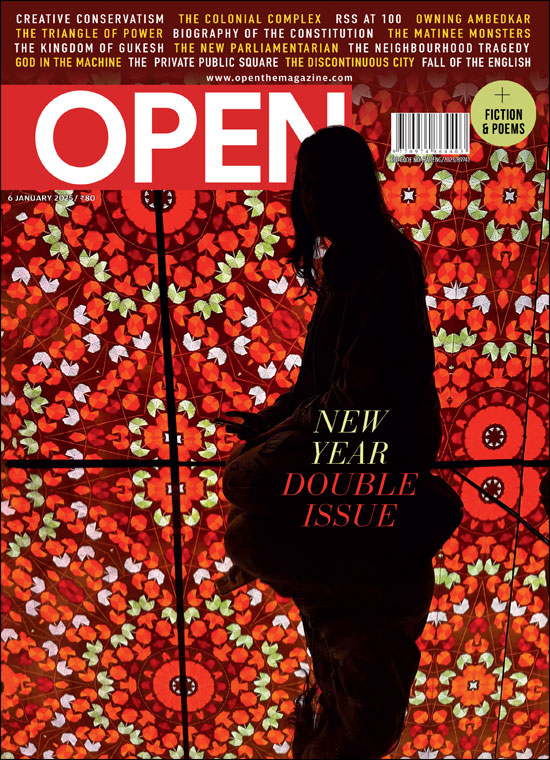Tired of the silk and jewellery of Bharatanatyam, Gitanjali Kolanad discovered the martial art Kalaripayat in her thirties, a little late in life.
“Wash the floor of the kalari with your sweat.” I’d heard that injunction, and my body was obeying it. What started as wet patches under my arms spread across my back, torso, hips, soaked through my kurta, and was now dripping off my arms, face and neck, making the floor wet all around me. But it is a mud floor, so my sweat has no cleansing effect on it whatsoever. Rather, it is absorbed into the reddish earth, turning it slippery and creating one more impediment to the perfect execution of the movements. The advanced students make it look easy, kicking so high that the top of the foot meets the palm of the hand, held straight up above the head, with a satisfying slap, slap, slap at the top of each kick. Not for the first time, I think, ‘I’m too old to be doing this.’
Early in the morning, the children and young men and women of the neighbourhood come to the kalari—the place of practice. It is a large space, dug deep into the ground and built to prescribed proportions, with the seven-stepped symbol of the stages of Kalaripayat mastery in the south west corner, and protected by deities in each direction. The sounds of the Malayalam syllables shouted out as instruction can be heard along with the rooster’s insistent crowing. “Idathu vecchu. Vallathondu chauti…” Vijayan Gurukkul is reciting the instructions for the attack-defence sequences with an imaginary opponent: “Step with the left foot, jump with the right…”
I watch the young lithe bodies, long muscles under dark skin glistening with oil and sweat. They crouch and kick and leap, taking inspiration from the movement of the elephant, lion, horse, snake. The actions are low to the ground, curving, punctuated by sudden high twirling jumps, just like the Malayalam script, all curves interrupted only rarely by a straight line.
Even though I was born in Kerala, the place where Kalaripayat originated, I saw it for the very first time in Delhi. Kavalam Narayana Panicker came with his troupe, Sopanam, to perform at a theatre festival. The play was in Malayalam. I didn’t understand much, my mother tongue buried deep after so many years abroad. But language was irrelevant in the theatrical world that unfolded on the stage that evening. Don’t ask me for details, it was almost 30 years ago. What I remember is music, movement, energy—total theatre. The next day, there was a workshop. I was the only person who turned up, so I had the attention of the young actors all to myself. Gopi, their kalari master, showed me some of the movements, the high kicks, the basic postures based on animal forms. It was love at first try.
I went to Kerala later that year. I was in my thirties, too old right from the start. After having been involved with Bharatanatyam for 15 years, it no longer satisfied me. For all its beauty and precision, it seemed to be a rich girl’s prerogative, with the silk costume and jewels, the expensive, solitary classes, the futile struggle to perform. Kalaripayat provided an antidote to all that: boys do it, girls do it, the rich do it, the poor do it, Hindus, Muslims, Christians, they all do it.
Try it. Stand keeping your feet slightly more than hip width apart and parallel. Bend forward and put your hands on the floor in front of you, as if at the opposite corners of the square extending from your feet. Let your straight back make the space a cube. Stay just that low, but bring your arms up. Look up. Make fists in front of your face, forearms touching all the way from wrist to elbow. Can you feel what is elephant-like about you when you stand like that?
No other martial art in the world has this low animal crouch as the basis for all its sequences. At first I was awkward, ungraceful, leaden, always in pain. But eventually, I got better.
I am used to being both subject and object; as a dancer, one is both artiste and medium, what philosopher Merleau-Ponty calls ‘flesh’, the hand that reaches out to touch and is at the same time tangible. When I make the precise movements of an adavu, I feel what it feels like; at the same time, I see myself from the outside, the shape my body makes in space.
This is one of the pleasures of the martial arts, especially in the weapon sequences. The partner takes over the function of that watchful inner eye, melding subject and object into one. The rapid-fire pattern of hits is resonant and musical for stick on stick, metallic clang for dagger against dagger and shuddering thud for sword against shield. The dagger hits, or misses; hits correctly with just the right sound, the right feel or it doesn’t. The block is correct, or you get hit.
The first time my master hit me was during practice of the mucchan, a wooden stick about the length and thickness of a thigh bone. I was supposed to slide my hands along the stick as I blocked to avoid just such a hit, but I kept forgetting that movement, again and again. The next time, the blow landed hard on my knuckles, the pain eliciting a sharp intake of breath. “Master, you hit me!” I said.
“You didn’t block. Keep going!” was his only response. By the time I finished the sequence, the fingers of my right hand were swollen. “I think my fingers are broken,” I said, feeling very sorry for myself. He took my hand in his and felt each finger and each joint thoroughly, because the kalari master is also the village doctor, trained in a system using energy points on the body called marmas, and herbs and massage to set bones, heal sprains and treat all forms of muscle pain and strain. “No. Nothing broken. Again!” This time, I blocked.
My teacher’s daughter had a finger sliced to the bone by the urumi, the flexible sword, the most dangerous of kalari weapons, with which you can decapitate yourself if you aren’t careful. But no one gave her much sympathy, saying, “She didn’t block properly.” This year, I have a large purple bruise on my forearm, from not holding the dagger at the right angle, so that when the hit lands, part of the handle is bashed into the flesh. The pain reminds me that I am too old for this. But as I become more accurate in my defence, the bruise will fade. Pain is a good teacher.
What is a human being? What is consciousness? How exactly is my body ‘mine’? These are not simple questions. We usually answer by referring to the brain, as if what we are happens inside the skull. But we are embodied beings: ‘The body is our general medium for having a world,’ writes Maurice Merleau-Ponty.
Perception itself is an active, creative process. We select our experience of the world. There is a story in The Mahabharata about the great archer Arjuna that illustrates this point. The guru gives all his students an exercise: they must shoot an arrow through the eye of a fish painted on a flag flying from a tall mast. All the other archers fail, but Arjuna does it with one arrow. His brother asks him, “Didn’t the wind disturb you?” “What wind?” “The wind blowing the flag.” “What flag?” “The flag with the fish painted on it.” “What fish? I saw only an eye.” As William James put it, ‘My experience is what I agree to attend to.’
The Kalaripayat practitioner does not aspire to Arjuna’s pinpointed focus, but to an awareness where one experiences the wind, the flag, the fish and yet puts the arrow right where it should go; a state of mindfulness where ‘the body becomes all eyes’, the whole body as responsive to the world as the eyeball is to visual stimuli.
There is no place in the brain where perception ends and action begins; the two are so completely enmeshed. What we perceive affecting and changing our actions, moment to moment, in turn affect and change what we perceive. Just because we don’t consciously perceive sensory information doesn’t mean that it’s not encoded; my arm lifting to block a hit adjusts itself as the opponent changes his attack. Scientists theorise that there are two sensory systems in the brain: one that represents stimuli and another that uses it directly to move the body in space.
In the practice of kalari, nothing is made explicit about philosophical aspects of the form. All my master tells me is, “Look into my eyes.” Then he comes at me incredibly fast with the weapon, attacking head, groin, ribs from either side, and ankles, so that there is no time to think about where or how. Under his blistering attack, the dichotomies of subject/object, body/mind, thought/action dissolve into flowing movement.
Once, after I’d been studying Kalaripayat for a few years, I was walking along a street in Nizamuddin at dusk. A man was walking towards me. As we passed by each other, he put out his hand, squeezed my breast, and kept on walking. Without any conscious thought, in one fluid motion I turned, letting my shoulder bag slip down my arm to my wrist, grabbing it and swinging it in a wide arc so that it hit him with a satisfying thud—my bag had books in it (hardcover). I caught him right on a marma point, on the side of his head, one I’d been practising hitting with the mucchan.
The creep was angered by the hit, and turned, rushing at me as if he were going to attack. I was already in my fighting stance, feet apart and stable. He was the one who backed away, muttering obscenities.
This was, of course, not the first time that my breast had been groped in India, but it was the first time I had responded with physical violence. It was very satisfying. While little boys fight and scrap from a young age, girls don’t grow up playing those games. We have a hard time hurting someone else, even a stranger who has molested us. Yet, female energy, expressed violently, is revered in India. Kali is the presiding deity of the kalari. Kalaripayat puts me in touch with that aspect of my nature. It demystifies physical conflict and breaks it down into parts. Women, being most often the victims of violence, have the most to gain by understanding the mechanics of it.
In practice, the movements are so beautiful that I have to remind myself they are conceived with a deadly purpose. Dualities merge: strength and grace, body and mind, male and female, pain and pleasure. Through Kalaripayat, I become whole.
Gitanjali Kolanad teaches Kalaripayat and has also been a Bharatnatyam dancer for 30 years. Her book, Sleeping with Movie Stars, has recently been published by Penguin
/wp-content/uploads/2015/11/Ll-kalari.jpg)

/wp-content/uploads/2024/12/Cover_Double-Issue-Spl.jpg)












More Columns
The Heart Has No Shape the Hands Can’t Take Sharanya Manivannan
Beware the Digital Arrest Madhavankutty Pillai
The Music of Our Lives Kaveree Bamzai